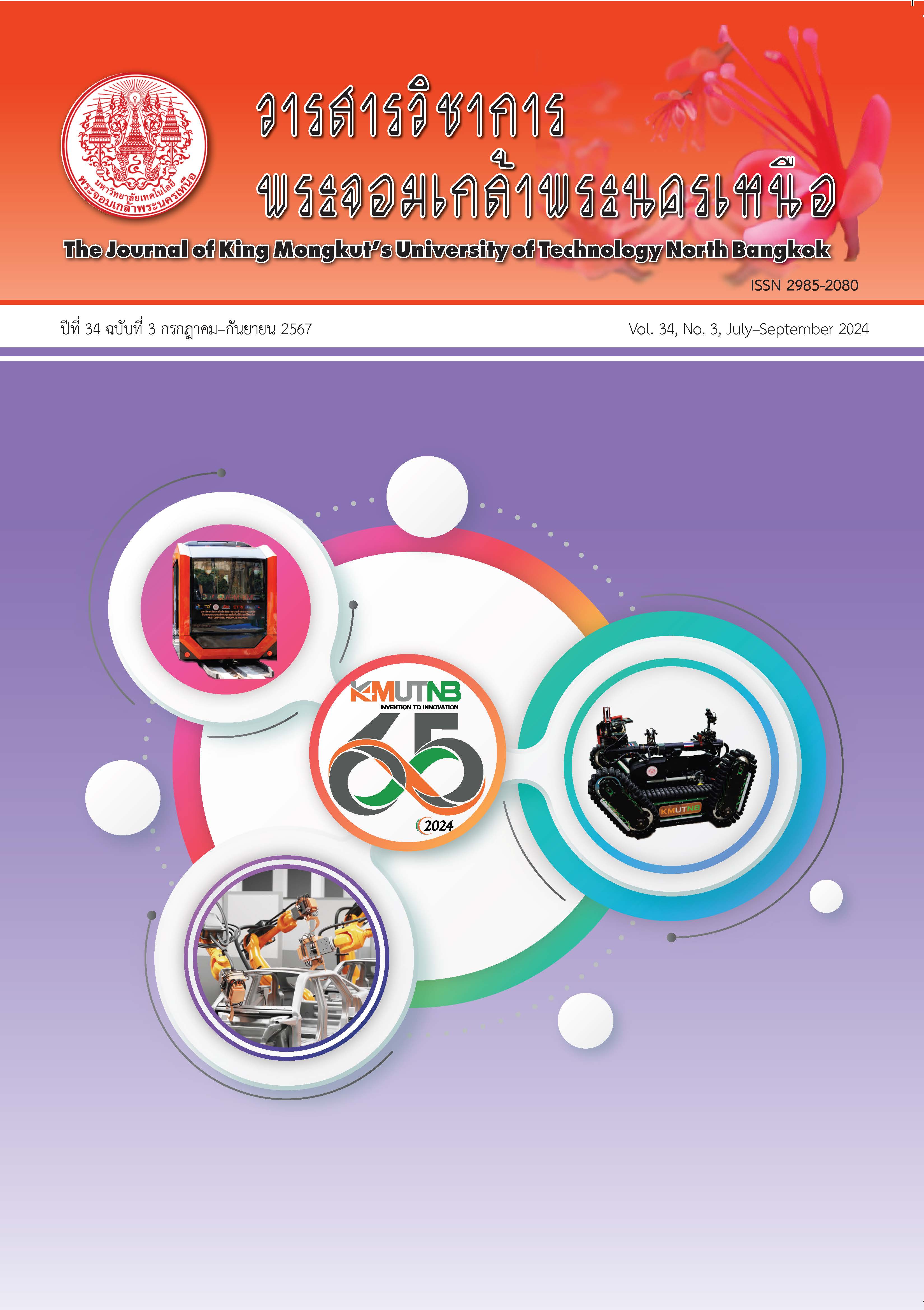The Solutions of Overbank Flow to Mitigate the Effects of Flooding for Small Streams
Main Article Content
Abstract
This research aims to study and recommend appropriate overbank flow solutions to mitigate flood impacts related to a small stream. For the purpose of this research, Huai Rai stream in Mae Rai Sub-district, Mae Chan District, Chiang Rai Province was selected for the case study.The HEC-RAS model was used to simulate the distances of overbank flows repeatedly occurring for 10 years and the residual flooding distances resulting from different measures taken to reduce the flows.The simulation accuracy was calibrated to a Nash-Sutcliff efficiency of 0.92, which is highly reliable.The results showed that there was flooding along 1,155 meters of the stream.The use of individual structural measures for flood prevention could not resolve the problems caused by flooding. On the other hand, cross section improvement of existing bridges and culverts, dredging of the sedimentation upstream of the weir, and removing stream obstructions were exposed to reduce the flood ranges to 832, 875 and 1,076 meters, respectively. By choosing all structural measures in combination with additional stream improvements, we found that the total flood distance can be further reduced. Taking key issues, such as impact on communities, property and quality of life into consideration, the cross section improvement of bridges and culverts should be the first priority as this would provide the greatest way to reduce flooding.
Article Details

This work is licensed under a Creative Commons Attribution-NonCommercial-NoDerivatives 4.0 International License.
The articles published are the opinion of the author only. The author is responsible for any legal consequences. That may arise from that article.
References
Thairath Online. (2018, Aug.). Heavy rain, flash flood from Doi Tung floods 7 villages in Chiang Rai. TREND VG3 Corp. Ltd. Bangkok, Thailand. [Online]. (in Thai). Available: https://www. thairath.co.th/news/local/north/1353969.
Faculty of Engineering Chiangmai University, “Integration of water resources management project: The development activities of information system for prepare to flood disaster and landslides in Chiang Rai Province,” Chiangmai University, Chiangmai, Thailand. Report, Mar. 2020 (in Thai).
Office of the National Water Resources. (2019, Aug.). The 20 year National Water Resources Management Master Plan (2018–2037). Office of the National Water Resources, Bangkok, Thailand. [Online]. (in Thai). Available: http:// www.onwr.go.th/?page_id=4174
P. Chanla, “Flood area analysis using HEC-RAS model in the Lamtakong Basin,” M.Eng. Thesis, Department of Civil Engineering, Faculty of Engineering, Suranaree University of Technology, Nakhon Ratchasima, 2018 (in Thai).
P. Chanla and P. Kosa, “Flow estimation using HEC-RAS model a case study of Lam Takong river basin,” Technical Education Journal: King Mongkut’s University of Technology North Bangkok, vol. 11, no. 1, pp. 1–11, 2020 (in Thai).
S. Sairattanain, “River flow and floodplain modeling by HEC-RAS: A case study from Mae Lao River, Chiang Rai Province,” Ph.D. dissertation, Department of Computational Science, Mae Fah Luang University, Chiang Rai, 2010 (in Thai).
S. Pirom, “Flood simulation using HEA-RAS model and geographic information system for flood relief in the lower Chao Phraya River Basin Using Retention Ponds,” M.S. Thesis, Department of Environmental Science, Graduate School, Silpakorn University, Nakhon Pathom, 2011 (in Thai).
B. Khantithirakawee, “HEC-RAS model application for flood management in upper Nan river basin,” M.Eng. Thesis, Department of Water Resources Engineering, Faculty of Engineering, Kasetsart University, Bangkok, 2012 (in Thai).
M. Zelenakova, R. Fijko, S. Labant, E. Weiss, G. Markovic, and R. Weiss, “Flood risk modelling of the Slatvinec stream in Kruzlov village, Slovakia,” Journal of Cleaner Production, vol. 212, no. 1, pp. 109–118, 2019.
S. Prechaverakul and T. Yongsatitsak. (2015). Development of a Flood Model for Hatyai Municipality Using HEC-RAS. [Online]. (in Thai). Available: http://kb.psu.ac.th/psukb/handle/ 2016/17007
HEC-RAS River Analysis System User's Manual Version 5.0, US Army Corp of Engineers, Davis, CA, 2016, pp. 19–23.
HEC-RAS River Analysis System Hydraulic Reference Manual Version 5.0, US Army Corp of Engineers, Davis, CA, 2016, pp. 26–255.
J. E. Nash and J. V. Sutcliffe, “River flow forecasting through conceptual models; Part I-a discussion of principles,” Journal of Hydrology, vol. 10, pp. 282–290, 1970.
D. N. Moriasi, J. G. Arnold, M. W. Van Liew, R. L. Bingner, R. D. Harmel, and T. L. Veith, “Model evaluation guidelines for systematic quantification of accuracy in watershed simulations,” American Society of Agricultural and Biological Engineers, vol. 50, no. 3, pp. 885–900, 2007.
The Committee of middle price and entrepreneur registration. (2017, October). The criteria for construction cost estimating of middle price in Irrigation Construction Work. The Comptroller General's Department, Bangkok, Thailand. [Online]. (in Thai). Available: https://shorturl.asia/dr6mw
J. Garrotea, N. Bernala, A. Díez-Herrerob, L. R. Martinsb, and J. M. Bodoquec, “Civil engineering works versus self-protection measures for the mitigation of floods economic risk. A case study from a new classification criterion for cost-benefit analysis,” International Journal of Disaster Risk Reduction, vol. 37, 2019.
C. Chiamsathit, S. Janya, and P. Khumyos, “Community participation in the solutions to recurrcnt flooding and water shotages of Banchan Village, Kalasin Provice,” Area Based Development Research Journal, vol. 12, no. 6, pp. 416–431, 2020.
Y. Ding and S. S. Y. Wang, “Optimal control of flood diversion in watershed using nonlinear optimization,” Advances in Water Resources, vol. 44, no. 1, pp. 30–48, 2012.
K. Wang, Z. Wang, K. Liu, L. Cheng, Y. Bai, and G.Jin, “Optimizing flood diversion siting and its control strategy of detention basins: A case study of the Yangtze River, China,” Journal of Hydrology, vol. 597, no. 1, pp. 1–14, 2021.

